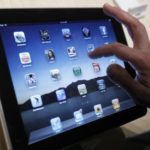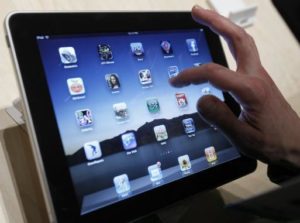
Technology experts say Apple’s latest gizmo, the iPad, won’t replace students’ laptops, but a menu of applications will help teach the periodic table, a range of languages, and a host of other K-12 and higher-education subjects.
More than 300,000 iPads were sold April 3 in Apple Stores and through pre-orders, Apple announced April 5, and education technology enthusiasts finally got to experiment with the device that Apple CEO Steve Jobs describes as a “game changer.”
The iPad App Store is stocked with more than 150,000 downloadable programs, including some that might catch educators’ attention.
“The Elements: A Visual Exploration” guides students through every part of the periodic table with stunning graphics of each element, presenting an old lesson plan in a captivating platform.
Hello-Hello.com, a language learning web site that launched last year, released its iPad app April 1, offering access to the site’s entire Spanish course and allowing access to social networking sites where students can chat with native speakers of the language they are studying.
Hello-Hello.com plans to release iPad apps covering more languages in the coming weeks, according to a company announcement.
WolframAlpha, an online search engine that caters to researchers, released an iPad app that connects directly to the WolframAlpha supercomputing cloud, a potential boon for campus research teams who could continue their work with a device that is more portable than even a laptop, experts said.
Educational iPad applications can cost $2, $15, or more, but some programs are available for free, like the “USA Factbook,” which features descriptions of all 50 states. There’s also “States & Capitals” for no charge in the iPad apps store, designed for students prepping for a geography quiz or exam.
Ronald Yaros, an assistant journalism professor at the University of Maryland, was among the iPad early adopters—Yaros ordered the eReader device shortly after Apple unveiled it in February—and said the product could be useful for students interested in the evolution of news consumption.
“To those professors who don’t use technology, it’ll be revolutionary,” said Yaros, whose curriculum is centered around new media and technology. “I would say it’s another tool in the toolbox. … It depends on how [tech-savvy] the professor is.”
Yaros, an avid Apple consumer with an iPhone and several Apple laptops, said the iPad takes some “getting used to” because its keys are flat on the screen, rather than raised like a traditional keyboard.
“You have to have it positioned just right to type,” he said.
News site applications such as The New York Times and the Associated Press (AP) could serve as worthy journalism class lessons, Yaros said, especially for students studying electronic presentation of the news.
The AP iPad app, for instance, has headlines with corresponding photos near the bottom of the iPad screen. Yaros said the subtle placement of stories that might pique readers’ interest—even when an iPad user is perusing another AP story—should be a lesson in itself for his students.
“The stories just kind of float across the bottom of the screen, and they come with what I would call explanatory headlines,” he said. “They don’t tease the reader so much, and that’s something I tell my students to avoid.”
Learning-management system giant Blackboard Inc. has joined the iPad store with its own application that lets students check their assignments, upcoming exams, and class grades on the Apple tablet. In an April 5 announcement, Blackboard said its app would be free for iPad users in “an effort to help institutions get started quickly in mobile [technologies] and to encourage use of the iPad as a learning tool.”
The program, called Blackboard Mobile Learn, will be available in June on platforms for students who use the iPhone operating system, BlackBerry, and Google Android.
Officials at Seton Hill University in Greensburg, Pa., were perhaps the earliest iPad adopters in education, announcing March 30 that all full-time students would receive an iPad beginning in the fall 2010 semester.
Providing the latest eReader for students is part of the university’s Griffin Technology Advantage Program launch, which “provides students with the best in technology and collaborative learning tools, ensuring that Seton Hill students will be uniquely suited to whatever careers they choose—even those that have not yet been created.”
Seton Hill also will provide 13-inch MacBooks for full-time students. The students will own each Apple device, meaning they can take the iPad and laptop off campus and keep the products after graduation, according to the university’s announcement.
The University of Maryland partnered with the International Children’s Digital Library (ICDL) to create a free iPad app for online children’s books in more than 50 languages. The application gives access to a children’s search engine designed by Maryland’s Human-Computer Interaction Laboratory to sift through ICDL’s 4,000 book titles.
“In today’s digital and global age, children should be encouraged to read anytime and anywhere,” said Michael Levine, executive director of the Joan Ganz Cooney Center at Sesame Workshop, which supports investment and research in digital technologies. “ICDL for iPad does just that.”
The iPad has gotten mostly favorable reviews from technology writers, although some—such as New York Times technology columnist David Pogue—caution that the device isn’t meant to replace a laptop.
“The iPad is … not nearly as good for creating stuff,” Pogue concludes. “On the other hand, it’s infinitely more convenient for consuming it.”
Links:
Blackboard iPad app announcement
- Research: Social media has negative impact on academic performance - April 2, 2020
- Number 1: Social media has negative impact on academic performance - December 31, 2014
- 6 reasons campus networks must change - September 30, 2014
